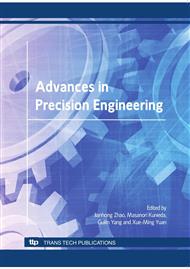p.770
p.775
p.780
p.785
p.790
p.795
p.801
p.806
p.811
Effects of Molding Parameters and Addition of Fillers on Gate Chip Off Formation during the Degating Process in Transfer Molding
Abstract:
In the electronics packaging industry, Epoxy Mold Compound (EMC) polymer matrix is filled with fused silica (SiO2) to obtain the required roughness and hardness. Gate chip off, which occurs during the degating process in transfer molding is one of the common defects which contributes to the failure in the proper functioning of the package. During the degating process, surface contact between two solid bodies (degating blade and gate) generate a high shear stress on package, thus creating a high potential for the incidence of gate chip of. In this study, the influence of transfer molding parameters and size of fillers (normal and fine) on the gate chip off were investigated. The application of Design of Experiments (DOE) using regression model and Analysis of Variance (ANOVA) showed that molding parameters do not significantly influence the incidence of gate chip off. Numerical simulation was used to investigate effect of two filler sizes and molding parameters on the mold fill time, end pressure of fill and shear stress at the wall. The results showed there were no significant influences on mold fill time but the fine filler showed lower pressure at the end of fill and lower shear stress at the wall. Experimental results of two sizes if filler shown that fine filler mold compound exhibited in reduction of gate chip off formation, compared to normal filler mold compound. Smooth surface of fine mold compound lead to decrease of friction shear stress during degating is expected contribute to this finding.
Info:
Periodical:
Pages:
790-794
Citation:
Online since:
September 2010
Authors:
Price:
Сopyright:
© 2010 Trans Tech Publications Ltd. All Rights Reserved
Share:
Citation:


